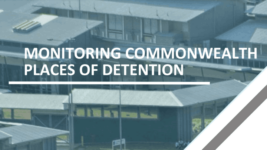Onshore Immigration Detention Centres are Rife With Abuses, Ombudsman Finds

During disturbances at Christmas Island’s North West Point Immigration Detention Centre early last year, staff were found to have engaged in using fire extinguishers and other firefighting equipment upon detainees.
This use was unauthorised but appeared to be planned and it wasn’t mentioned in incident reports.
Over the year 2021-22, Australia’s onshore immigration detention regime employed the use of potentially lethal spit hoods and it continued to lock up detainees long-term in alternative places of detention (APODs) like hotels, a recently released Commonwealth Ombudsman report has found.
Melbourne’s Park Hotel was continuing to operate as an APOD over that period, as it housed detainees transferred from offshore, and on one occasion, a man held there was served a maggot-infested dinner, which wasn’t replaced as staff found the fly larvae were “just on the vegetables”.
The 2021-22 report of the Commonwealth National Preventive Mechanism further identifies a practice that was occurring at Villawood Immigration Detention Centre, which involved property rooms being used as holding cells, so that those involved in incidents could cool down inside them.
And acting under the Commonwealth Ombudsman, the NPM inspection team found that these cells consisted of just a mattress on a concrete slab with a CCTV camera installed. There were no toilets, sinks or running water. And guidelines, limits on time use and records kept were non-existent.
Preventing rights abuses
Released on 20 January, the Monitoring Commonwealth Places of Detention report details the findings of Ombudsman-overseen inspections of ten federal institutions where people are deprived of their liberty.
These inspections were being carried out under the auspices of the OPCAT (Optional Protocol to the Convention against Torture), which is an international human rights instrument that aims to prevent abuses against those held in places of detention or closed environments.
Adopted by the United Nations in 2002 and ratified by this country in 2017, the OPCAT requires state parties to implement the national preventive mechanism (NPM), which consists of independent local inspection bodies that monitor detention facilities to curb future human rights violations.
Lauded in the nations that have implemented the protocol, OPCAT is also monitored by the Subcommittee for the Prevention of Torture (SPT), which is a UN body consisting of 25 independent experts, that visits countries a party to the treaty to randomly inspect its centres and provide advice.
The Commonwealth Ombudsman runs the NPM charged with monitoring federal detention facilities. And its report was released on a peculiar date, as it coincided with the Australian nation missing its second official NPM implementation deadline, as no state or territory NPMs are in operation.
Indefinite detention
The 2021-22 Commonwealth Ombudsman report is the first such comprehensive inquiry publicly released by the Commonwealth NPM, which is the only OPCAT inspection body operating in the country, despite the nation having had five years to roll out the UN-governed system.
Due to the restrictions around the COVID-19 pandemic during the reporting period, the Commonwealth NPM was only able to visit one AFP custodial centre, as well as one Australian Defence Force detention facility, along with eight immigration locations, including the Park Hotel.
“The Commonwealth Ombudsman remains concerned about delays in the case progression of people in long-term detention, including delays in administrative processes,” the report reads, as it highlights the ever-growing issue of immigration detainees being held in indefinite detention.
The report sets out that in June 2019, the average number of days an individual had been detained for was 485, while this has steadily grown to the point that in June last year, the average amount of days was 742.
And Home Affairs figures show that in October, 156 immigration detainees had been held within the Australian onshore immigration system for over 5 years.
The NPM has observed that long-term detention increases “the likelihood of systemic harm”, that many detainees would prefer to be in prison as they would then have a release date and that facilities used to house detainees were not built to accommodate individuals for long periods.
A revolutionary approach
In his forward to the report, Commonwealth Ombudsman Iain Anderson explains that the OPCAT is unique, as it is the “only exclusively preventive international human rights instrument”, and it’s also the first to rely on national bodies to monitor international human rights law.
While Association for the Prevention of Torture senior advisor Ben Buckland says in his introduction to the report that OPCAT was “revolutionary” in its approach when it was initially rolled out two decades ago.
Aspects of OPCAT that Buckland singled out as gamechangers include its questioning of practices, its focus on the vulnerable, its prevention of serious rights violations, its involvement of civil society groups, its opening the way for new places to monitor and the improvement it brings to staff.
“By creating an international system of visiting bodies, including the SPT at the international level and national preventive mechanisms domestically, the OPCAT gave birth to a world in which no place where people are deprived of liberty should remain closed to outside eyes,” outlines Buckland.
However, to the disgrace of our nation, when the SPT paid its first visit to Australia last October, the team of international experts had to cut its trip short as authorities in NSW and Queensland both denied it entry into certain places of detention that it sought to investigate.
Away from prying eyes
The Commonwealth Ombudsman made 18 recommendations to Home Affairs, as part of its 2021-22 OPCAT assessment. And the federal department has agreed to thirteen of the measures, rejected two and simply noted three of them.
Home Affairs has agreed to look at alternatives for long-term detainees, that Australian Border Force staff should record reasons for their use of mechanical restraints on detainees and to have a contingency plan for alternative food sources if meals served are found unfit for consumption.
However, the department has merely noted a recommendation to lower onshore immigration detainee numbers and its rejected a suggestion that it put in strategies to allow family visits regardless of whether a detainee or their family member have been COVID vaccinated.
The report also notes that at the time of publication most states and territories – the Australian Capital Territory, the Northern Territory, South Australia, Western Australia and Tasmania – have appointed a body responsible for the local NPM, however NSW, Victoria and Queensland had not.
And while the Commonwealth NPM is running smoothly, all other jurisdictions have failed to establish their own, and, in considering the attitude that certain states had to the visit of the SPT last year, it doesn’t look like various Australian governments are in any hurry to implement OPCAT.







